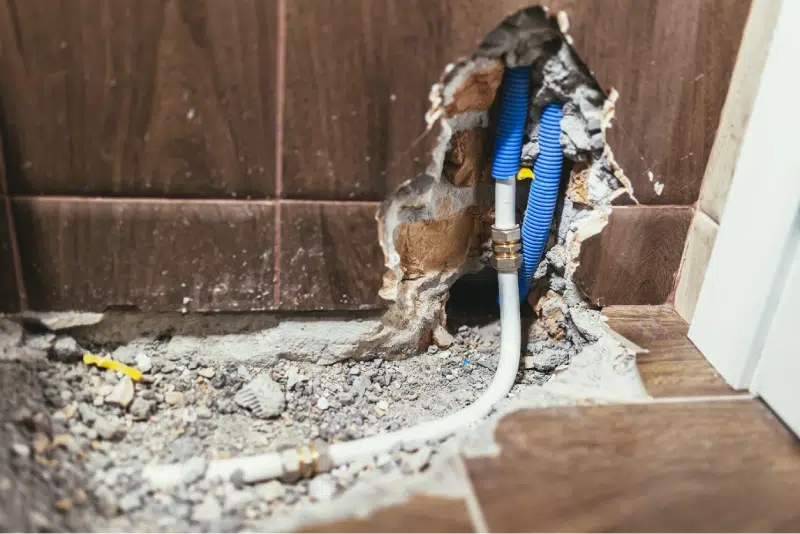How to Get Your Landlord to Make Repairs
If a landlord is not responding to multiple written repair requests, the tenant must force the landlord to make repairs. Do not be fearful. The law actually protects a tenant that asserts rights against a landlord. In fact, Cal. Civil Code § 1942.5 creates extra protection for a tenant from eviction for 180 days after a repair request.
File a Lawsuit Against Owner
Depending on the severity of the repair issues, a tenant may have claims against a landlord that can be litigated in Superior Court. For major, ongoing violations, such as no heat, mold, sewage, rodents, leaks, holes in walls, security lapses, and electrical and plumbing issues, an attorney may take a case on contingency. When a case is taken on contingency, the client does not pay until money is recovered. Damages in an affirmative lawsuit can include return of rent paid, punitive damages (punishing the landlord), payment for emotional suffering, and damages for physical harm.
Under California law, tenants may have one or more of the following causes of action against a landlord:
Breach of Warranty of Habitability
Implied in every residential lease is a warranty of habitability. See Green v. Superior Court, 10 Cal. 3d 616, 638 (1974). California Civil Code § 1941.1 provides the minimum requirements for a habitable residential unit: a) effective waterproofing; (b) unbroken windows and doors; (c) working plumbing and gas facilities; (c) hot and cold running water; (d) proper sewage system; (e) heat; (f) working electrical lighting and wiring; (g)clean grounds; (h)no rodents and vermin; (i) an adequate number of garbage cans; (j)floors, stairways, and railings maintained in good repair; and (k) a locking mail box.
To prove a claim for breach of warranty of habitability, a tenant must show: (1) an uninhabitable condition; (2) actual knowledge by landlord or constructive knowledge; and (3) damages. Stoiber v. Honeychuck, 101 Cal. App. 3d 903, 918-19 (1980). Constructive knowledge means that a landlord should have known or could have known about the issue with reasonable inspection.
Damages for breach of warranty of habitability include return of rent paid and attorney fees. The statute of limitations for breach of warranty of habitability is two years for an oral lease and four years for a written lease. Cal. Code Civ. Proc. §§ 339 and 337. This means that a tenant can only claim a return on rent for two years back on an oral and four years back on a written lease.
Negligent Infliction of Emotional Distress
Almost always, a failure to make repairs leads to emotional suffering by a tenant. Emotional suffering includes anguish, fright, horror, nervousness, grief, anxiety, worry, shock, humiliation, and shame. The damages for a claim of negligent infliction of emotional distress are calculated by how much suffering a tenant endured. It is difficult to measure. One thing a tenant can do to help with a damage calculation is to keep a log to track their emotional distress, eg. “May 1, 2010 at 1 a.m. – could not sleep because I could hear rats gnawing at the sofa.”
To prove a claim for negligent emotional distress, a tenant must show that: (1) the landlord negligently cared for the property; (2) the tenant suffered serious emotional distress; and (3) the negligence caused the emotional distress. CACI No. 1620. Serious emotional distress exists if an ordinary, reasonable person would be unable to cope with it. Id. The statute of limitations for negligent infliction of emotional distress is two years. Cal. Code Civ. Proc. § 335.1.
Intentional Infliction of Emotional Distress
In extreme cases of landlord neglect, a tenant may seek recovery for intentional infliction of emotional distress. Stoiber v. Honeychuck, 101 Cal. App. 3d at 921. The elements of the tort are: (1) outrageous conduct by the landlord; (2) intent to cause emotional distress or reckless disregard of the probability of causing emotional distress; (3) severe emotional suffering; and (4) actual and proximate causation. Id., citing Newby v. Alto Riviera Apartments, 60 Cal. App. 3d 288, 296 (1976). A tenant can be awarded punitive damages for intentional infliction of emotional distress. Punitive damage claims are not covered by a landlord’s property liability insurance. A filing of a claim for intentional infliction of emotional distress is likely to make a landlord very nervous because it is not covered by insurance. This increases the likelihood of settlement. The statute of limitations on a claim for intentional infliction of emotional distress is one year. Cal. Code Civ. Proc. § 340.
Constructive Eviction
When repair issues force a tenant to abandon a property, the tenant can file a cause of action for constructive eviction. Stoiber v. Honeychuck, 101 Cal. App. 3d at 921, citing Groh v. Kover’s Bull Pen, Inc., 221 Cal. App. 2d 611 (1963). The property must be in such ill repair that it is unfit for use. Id.
The statute of limitations for constructive eviction is two years for an oral lease and four years for a written lease. Cal. Code Civ. Proc. §§ 339 and 337. This means that a tenant must file a claim within two or four years of move out.
Negligence and Negligence Per Se
The landlord may also be liable for physical injuries, including illness. If the landlord has violated a state or local statute and the violation has caused injury, the landlord is presumed to be liable under California law. See CACI No. 418 and Cal. Evid. Code § 669. This means that a jury or judge must presume landlord liability. The landlord can overcome this presumption by showing that the landlord took steps to protect tenants beyond those required by state and local law. A claim for negligence must be brought two years from the date of injury. Cal. Code Civ. Proc. § 335.1.
Violation of Local Rent Ordinance
Local rent ordinances often contain provisions that allow punitive damage awards against landlords. These provisions typically protect tenants against wrongful eviction or illegal rent increases. If the tenant can show that a landlord refused to make repairs because the tenant was paying rent controlled rent, then the tenant could get a punitive damage award against the landlord. The statute of limitations on a punitive damage claim is one year. Cal. Civ. Proc. § 340.
Claim for Uncured Building Inspection Violation Under Cal. Civ. Code § 1942.4
Where a landlord has failed to correct a building inspection notice within 35 days, each tenant is entitled to actual damages, plus a penalty of $100 to $5,000 as determined by a court, Cal. Civ. Code § 1942.2. These damages are in addition to any other claims the tenant may have. The term “actual damages” includes damages for emotional distress. McNairy v. C.K. Realty, 150 Cal. App. 4th 1500 (2007). The statute also mandates an award of attorney fees to the prevailing party. Cal. Civ. Code § 1942.2(b)(1)(2).
All of the following elements must be shown: (1) the building has a substantial defect that violates Civ. Code § 1941.1, Health & Saf. Code § 17920.10, or Health & Saf. Code § 17920.10 17920.3; (2) the landlord received a notice of violation from the building inspector; and (3) the landlord did not make the necessary repairs within 35 days.
Unfair Business Practices
A tenant may also recover retroactive rent under a claim of unfair business practices. Cal. Bus. & Prof. Code § 17200. The damage award is cumulative, so an award for unfair business practices does not reduce an award under alternate causes of action. Id. § 17205. A tenant must be in possession to proceed with a claim for unfair business practices. Stoiber v. Honeychuck, 101 Cal. App. 3d 903, 928, citing Barquis v. Merchants, 7 Cal. 3d 94, 110 (1972).
File a Petition With the Local Rent Control Agency
Several cities allow a tenant to file a petition against a landlord to have rent payments reduced until repair issues are resolved. See San Francisco Rent Board Decrease in Services Petition; City of Oakland Rent Adjustment Program Decrease in Housing Services Petition; and City of Berkeley Rent Stabilization Board Individual Rent Adjustment.
The tenant must show a substantial decrease in housing services. This could include no heat, mold, sewage, rodents, leaks, holes in walls, security problems, and electrical and plumbing issues.
Rent control agencies have the power to reduce rent only, which means the tenant must continue to live in the substandard unit to recover. Tenants can recover up to three years back rent. Since a tenant must live in the unit, this is not always the best avenue. But, if a landlord does not have money to pay a judgment in a lawsuit at Superior Court and does not have property liability insurance, a petition with a local rent control agency may be the only way for a tenant to recover.
Report to the City Building Inspector
Nothing gets a landlord moving forward with a repair faster than contacting the department of building inspection. The building inspector will force the landlord to make the repairs by issuing fines for non-compliance. Even though the inspectors tend to be very good at their jobs, it is advisable for tenants to be present on the day of inspection to point out repair issues to the inspector.
Do not call the building inspector if a unit is illegal. The building inspector may require the landlord to destroy the unit.
Repair and Deduct
A tenant can repair an unlivable condition and then deduct the cost from the rent. Cal. Civ. Code § 1942. This is a dangerous strategy and is not recommended. If done incorrectly, it could result in a three-day, non-payment eviction notice and an eviction lawsuit.
To do it correctly, the following steps must be taken:
- tenant must ask for the repair in writing and give the landlord 30-days to repair, or shorter if an emergency situation;
- tenant can then pay to repair the condition at the cost of up to one month’s rent; and
- tenant can then deduct the amount from the rent.
Repair and deduct can only be done two times per year. Id.


